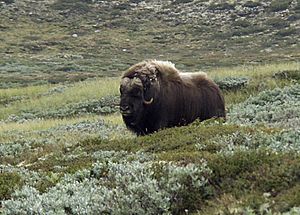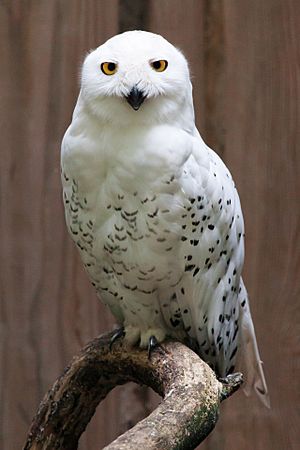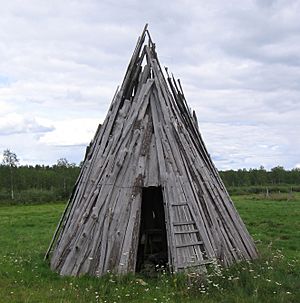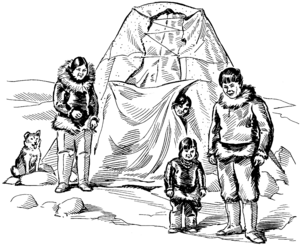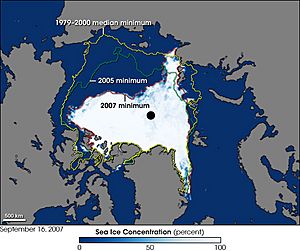Arctic facts for kids
The Arctic is the area around the Earth's North Pole. It includes parts of Russia, Alaska, Canada, Greenland, Lapland, and Svalbard. The Arctic Ocean is also a big part of it, mostly covered with ice.
Most scientists define the Arctic as the area north of the tree line. This is where trees stop growing because it's too cold. The land in the Arctic is often covered with tundra. A tundra is a cold, flat area with almost no trees. Instead, it has moss and grass-like plants called sedges.
Tundras don't get much rain or snow. But they can be very wet in summer. This is because about one meter (three feet) below the surface, the ground is always frozen. This frozen layer is called permafrost. It's as hard as stone and stops water from soaking deeper into the earth. In summer, the top layer of ground thaws, and melted snow can't drain away. So, it forms lakes and puddles until it freezes again or dries up.
In the Arctic, during summer, the Sun sometimes never sets. This happens because the North Pole points towards the Sun. That's why some people call it the Land of the Midnight Sun.
The word "Arctic" comes from the Greek word arktos, which means "bear". The North Pole points towards the star groups known as the Great Bear and the Little Bear. This is why the region is called the Arctic.
Contents
Arctic Climate
The Arctic has very cold winters and cool summers. It doesn't get much snow, usually less than 50 centimeters (20 inches) a year. Strong winds often blow the snow around, making it seem like it's snowing all the time. Winter temperatures can drop to about -40°C (-40°F), and the coldest temperature ever recorded was around -68°C (-90°F).
Areas near the coast are a bit warmer and get more snow because of the ocean. Inland areas are colder and drier. The Arctic is being affected by global warming. This is causing sea ice to melt and the Greenland ice sheet to shrink. As the permafrost thaws, it can also release gases.
Because of global warming, the Arctic region is actually getting smaller. Scientists predict that the Arctic sea ice could almost completely disappear in September sometime between 2035 and 2067.
Arctic Plants
In some parts of the Arctic, the ground is covered with bright flowers during the short summer. These small plants have very short stems. They stay close to the ground because the earth is warmer than the strong winds above it.
Even some rocks have plants growing on them. These are called lichens. Yellow reindeer moss is actually a type of lichen. It grows slowly but can reach over 15 cm (six inches) tall. It's spongy and full of water, and it's a main food source for reindeer in summer.
Trees are rare on the tundra. Only in sheltered valleys or along riverbanks can small trees grow. Rivers flowing into the Arctic from warmer areas make their banks a bit warmer. Otherwise, you'll only see a few groups of bushes. Berries are the only fruit that grows in the Arctic.
Each summer, the ice and snow melt. This allows animals to find food and plants to flower. The moisture from the melted snow stays near the surface, which plant roots can use. Still, in many places, the soil isn't good enough for plants to grow. Less than half of the tundra has plants on it.
Arctic Animals
The polar bear is the world's largest meat-eating land animal. Polar bears are very good at hunting seals on the ice. They are excellent swimmers and don't mind the cold water. They have a very strong sense of smell, which helps them find seals. They eat and store fat when there's a lot of ice, as they can't catch seals in open water. After mating, females dig dens in the snow to have their cubs, usually twins. Bears mostly eat fish, bird eggs, seaweed, and dead whales, but they prefer seals or walruses.
The Arctic fox often follows polar bears to eat their leftovers. Foxes also hunt rabbits, lemmings, and voles. Lemmings and voles are like the rats and mice of the Arctic. Lemmings have very short tails. They live underground in summer but under the snow in winter because the topsoil freezes. They eat plants and roots. In years with lots of food, millions of lemmings roam the tundra. This means more food for owls and foxes, so they have more young. But the tundra can't feed so many lemmings, so many starve or are eaten.
Caribou and their relatives, the reindeer, also live in the Arctic. Caribou are mostly found in North America and are larger than reindeer. Large herds eat grass and lichens. In fall, they move south to warmer winter feeding grounds. They use their sharp hoofs to dig through the snow for food. Their hollow fur traps air, keeping them warm. In spring, they return north to summer pastures, where their calves are born. Just an hour after birth, calves can follow the herd. Most of the world's reindeer live in Europe and Asia. Some are not wild; they are tamed by herders who protect them from wolves and guide their migrations. The musk ox, which looks like a shaggy buffalo, also lives in the Arctic.
In summer, many birds visit the Arctic. Most are water birds, like geese, ducks, swans, loons, and Arctic terns. They fly in for the summer, raise their young, and then fly south for winter. The snowy owl and the ptarmigan stay all year. The snowy owl's color matches the snow. The ptarmigan's summer feathers turn white when it gets colder.
The smallest Arctic animals are flies and mosquitoes. In summer, thick swarms bite both people and animals. Reindeer try to escape mosquitoes by running to higher ground. The only real relief comes with snow and cold, when the swarms die off.
Human Life in the Arctic
Many people live in the Arctic, some for thousands of years. Eskimo and Lapp (Sami) people lived there long before modern tools. Other native groups include the Chukchi, Evenks, Iñupiat, Khanty, Koryaks, Nenets, Yukaghir, Gwich'in, and Yupik.
The Sami People
In a very northern part of Europe is a place called Lapland. It's not one country, but parts of four countries: Norway, Sweden, Finland, and Russia. The people who live there are called Lapps by outsiders, but they call themselves Sami.
There were different kinds of Sami people. Some lived by the ocean and fished. Others lived along warmer rivers, doing a little farming, hunting, and fishing.
But the most famous Sami were the nomads who raised reindeer. The Sami survived in their harsh homeland by taming reindeer. They got everything they needed from these animals. They ate mostly meat, milk, and cheese. Their clothes and tents were made from reindeer skins and wool. They are known for their beautifully decorated woolen clothing.
The Sami protected their herds, moving with them as they migrated from summer to winter pastures. They used trained reindeer to pull sleds carrying their supplies. In winter, the herds moved south of the treeline. The Sami would live nearby in homes made of logs or sod.
The Sami were very careful not to waste anything from the reindeer. Milk was used for drinking or making cheese. Meat was for food. Blood was frozen in chunks for soup and pancakes. Knives and belt buckles were carved from bones and antlers. Sinews were used as sewing thread. Cleaned-out stomachs were used to carry milk or cheese. Every part of a dead reindeer was used.
Winter clothing was made from layers of deer skin. The inner layer had fur facing in, and the outer layer had fur facing out. Boots were also made of fur, lined with grass gathered in summer. Every evening, the grass was taken out and dried by the fire to be ready for the next day. This way, a Sami person could stay warm and comfortable even in the coldest weather.
Today, only a few Sami still follow the herds. They use modern tools like snowmobiles to herd reindeer and rifles to protect them from wolves. Even helicopters and radios help find and move the reindeer. Most Sami now live on small farms in one of the four Lapland nations. They grow crops and raise animals, including some reindeer, for their needs. Selling reindeer meat is an important way for the Sami people to earn money.
Inuit People
Eskimos are also Arctic people. They sometimes ate raw meat. Inuit were also nomads, but they only had dogs, which they used for pulling sleds and hunting. They were hunters and gatherers, living off what they found or hunted. Like the Sami, they were very careful to use every part of the animals they hunted.
Inuit lived in tents during summer and in sod houses or igloos in winter. They made very clever things from bones, antlers, and wood. They also built different kinds of boats.
Inuit didn't have a formal government or laws. They learned early in life to help each other to survive. They always shared food and usually moved in small groups looking for food. Sometimes they gathered in larger groups to hunt big animals like whales. The men did the hunting and built homes, while the women cooked, made clothes, and cared for the children.
The Arctic Today
The Arctic region has many important minerals. Iron, lead, coal, copper, gold, and tin are all mined in different parts of this cold land. Large amounts of petroleum have been found in the Arctic in Russia, Alaska, and Canada. People live and work in the Arctic to remove and sell these valuable minerals.
For example, the oil in Alaska is very important to the United States. The main source is the Prudhoe Bay Oil Field on Alaska's north coast, found in 1968. Plans were quickly made to build a pipeline to bring the oil to a port that doesn't freeze, so it could be shipped south. Oil companies spent billions of dollars to build the Trans-Alaska Pipeline in the mid-1970s. It had to be built above the ground in the northern part because of the permafrost. Warm oil in the pipes could have melted the permafrost, causing the ground to sink and breaking the pipes, leading to an oil spill. The pipeline was finished in 1977. It brings oil to the seaport of Valdez on Alaska's south coast. From there, huge tankers take the oil to refineries along the west coast of the United States.
Russia has more land in the Arctic than any other nation. The Russian Arctic in Asia and the area just south of it is called Siberia. It's a very empty and harsh place. Historically, it was used as a place to send criminals and people who disagreed with the government. However, many people were also sent there to remove minerals, harvest trees from forests, and build cities.
Russia has a huge port city right in Lapland, inside the Arctic Circle. Murmansk is the largest city north of the Arctic Circle. The port stays ice-free because of the warm waters of the Gulf Stream, which flow up around Norway and Sweden from the South Atlantic. Huge icebreakers work to keep a path open for ships to reach the port. The port ships out fish, minerals, and lumber to Russia and the rest of the world.
The Arctic is also the shortest way for airlines to fly between some cities on different continents. For example, a flight from London to Tokyo is 1,400 miles shorter if it flies across the top of the world instead of the old route south across Europe and Asia. A flight from San Francisco to Norway is several hours shorter if it goes over the Arctic instead of across the United States and the Pacific Ocean.
So, people are using the Arctic in many ways, even though it's a difficult place to live.
Global Warming in the Arctic
The effects of global warming in the Arctic include rising temperatures, less sea ice, and the melting of the Greenland ice sheet. There's also concern about methane gas being released from the region, especially as permafrost and methane clathrates thaw. Because the Arctic is warming faster than the rest of the world, it's often seen as an early sign of global warming.
The Arctic is very sensitive to climate change. This is clear from the shrinking sea ice in recent years. Climate models predict much more warming in the Arctic than the global average. This has drawn a lot of international attention to the region. There are worries that the shrinking Arctic, caused by melting glaciers and ice in Greenland, could soon lead to a big rise in sea levels worldwide.
The current warming in the Arctic is causing ancient carbon to be released from thawing permafrost. This leads to the production of methane and carbon dioxide by tiny living things. Releasing these gases, which are powerful greenhouse gases, could cause fast and serious global warming.
Climate change is also expected to greatly affect tundra plants. It could cause more shrubs to grow, but harm mosses and lichens.
Images for kids
-
Marine fossils in Canadian Arctic
-
Baffin Island, Canada
-
Murmansk on Russia's Kola Peninsula is the largest city in the world north of the Arctic Circle.
See also
 In Spanish: Ártico para niños
In Spanish: Ártico para niños



